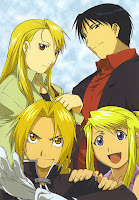 Suisei no Gargantia starts out as a space opera, in the
middle of a massive battle between humans and their arch-enemies, the
Hideauze. Ledo is a young lieutenant in
the human space force. He has been
battling the Hideauze his entire life, and war and fighting is all he knows.
Suisei no Gargantia starts out as a space opera, in the
middle of a massive battle between humans and their arch-enemies, the
Hideauze. Ledo is a young lieutenant in
the human space force. He has been
battling the Hideauze his entire life, and war and fighting is all he knows.
As the series begins, Ledo in his mecha, Chamber, is thrown
out of a battle and across space. He and
Chamber end up on a water world where humans are living on cobbled together
fleets of ships. They live by fishing
and trapping rain water for drinking, and they salvage old tech from the ocean
floor to trade with other fleets. Chamber,
with Ledo inside, is “salvaged” from the ocean, and Ledo finds himself living
with humans who are primitive by his standards on a massive fleet,
appropriately called Gargantia.
The initial interactions between Ledo and the members of the
fleet are not smooth. A young girl named
Amy takes Ledo under her wing, and begins to try to teach him to be more
human. Ledo has only two modes that he
knows how to operate in, battle and stand-by.
He doesn’t understand work and play.
He believes that only people capable of fighting deserve to survive, so
struggles with the existence of Amy’s crippled brother. When the fleet is approached by pirates, the
fleet asks for Ledo’s help. He kills all
the pirates since that’s what he knows, while they expected him to only help
them drive the pirates off.
Just as Amy is succeeding and Ledo is beginning to figure out how humans live on
this world, he discovers that primitive Hideauze live in the world’s oceans,
and he goes into extermination mode.
Unfortunately, the primitive Hideauze are held in almost religious
esteem by most of the fleet members and the interactions between them and Ledo become
even worse.
 Along the way, the head of the Gargantia fleet dies and his
young daughter takes over as fleet commander.
At that time, the fleets splits up and a salvage expert named Pinion convinces
Ledo to go with them . This splinter
group goes to wipe out a major Hideauze nest in order to salvage the tech under
them. This suits Ledo fine since he
would like to wipe out all Hideauze on the world. As Ledo exterminates the Hideauze in the
nest, including eggs and young, he comes across some shattering evidence. The Hideauze are evolved from humans. The water world they are on is the original
human world. It’s sun went nova and
before that happened two factions of humans existed, one who believed humans needed
to evolve into beings that could exist in space or in water, and the other
faction who believed that humans should stay humans. Even before humans left earth, and before
they finished evolving, the two factions began battling each other, and the
massive, never-ending space battles are a continuation of the battles between
evolving humans and non-evolving humans.
Along the way, the head of the Gargantia fleet dies and his
young daughter takes over as fleet commander.
At that time, the fleets splits up and a salvage expert named Pinion convinces
Ledo to go with them . This splinter
group goes to wipe out a major Hideauze nest in order to salvage the tech under
them. This suits Ledo fine since he
would like to wipe out all Hideauze on the world. As Ledo exterminates the Hideauze in the
nest, including eggs and young, he comes across some shattering evidence. The Hideauze are evolved from humans. The water world they are on is the original
human world. It’s sun went nova and
before that happened two factions of humans existed, one who believed humans needed
to evolve into beings that could exist in space or in water, and the other
faction who believed that humans should stay humans. Even before humans left earth, and before
they finished evolving, the two factions began battling each other, and the
massive, never-ending space battles are a continuation of the battles between
evolving humans and non-evolving humans.
Ledo is devastated to know that all his life he’s been killing
beings evolved from humans and he stops killing them. At this juncture, Ledo's former commander from space shows up. He has set himself and his mecha up as God, ruling the people in his fleet with an iron hand and
getting rid of those who aren’t useful.
Ledo originally joins his former commander, but when the commander sets
his sights on conquering Gargantia and making her people slaves, Ledo goes to
battle for Amy and the people of fleet Gargantia.

This series is fairly predictable at times, although I didn’t expect to find that the Hideauze started as humans. The characters are interesting, with Ledo’s mecha Chamber actually seeming occasionally more human than Ledo does early on in the series. The settings and characters are colorful and bright. And the mecha aspect is kept to a reasonable level instead of being the focus, like in so many mecha series. Overall it’s a good series to watch.
















